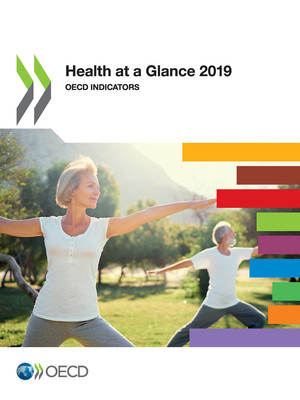copy the linklink copied!Breast cancer outcomes
Breast cancer is the cancer with the highest incidence among women in all OECD countries, and the second most common cause of cancer death among women (see indicator “Cancer incidence and mortality” in Chapter 3).
During 2010-14, an average of 51.5% of women with breast cancer were diagnosed at an early stage of disease in OECD countries, while 8.6% of women were diagnosed at an advanced stage (Figure 6.28). Countries with a high proportion of women diagnosed at an early stage, such as the United States and Japan, have a correspondingly low proportion of women diagnosed at an advanced stage. Since the 1980s, most OECD countries have adopted breast cancer screening programmes as an effective way of detecting the disease early (OECD, 2013[1]). This has contributed to higher proportions of women being diagnosed at an early stage.
In most OECD countries, five-year net survival for women with breast cancer has improved in recent years, reflecting overall improvement in the quality of cancer care (Allemani et al., 2018[2]). In all OECD countries, for women diagnosed at early or localised stage, the cumulative probability of surviving their cancer for at least five years is 90% and the international variation is small (Figure 6.29). However, net survival for women diagnosed at an advanced stage is still low and ranges widely, from about 30% in Austria and Lithuania to over 50% in Israel and Finland.
Motivated providers and patients across OECD countries are increasingly using patient-reported outcome measures (PROMs) for breast cancer to help inform difficult clinical decisions. Figure 6.30 presents crude outcome scores at 6-12 months following breast surgery (breast-conserving therapy and breast reconstruction) for 11 clinical sites from eight countries. Outcomes were measured using the relevant post-operative breast satisfaction scales from the BREAST-Q tool, an internationally validated instrument used to measure breast surgery outcomes reported by patients (Pusic et al., 2009[3]). Further results and analysis of this measure are provided in Chapter 2.
Figure 6.31 presents the proportion of women undergoing implant and autologous reconstruction surgery in the sample from each site. Consolidated crude scores from the participating sites indicate that women are 6% more satisfied with their breasts after autologous reconstruction surgery than after implant reconstruction (see Figure 2.9 in Chapter 2). This outcome aligns with existing evidence (Matros et al., 2015[4]) and can be an important consideration if choice of surgical intervention is possible.
These PROMs results are not representative for each country but do show the capacity for metrics of this kind to be reported internationally. Some OECD countries are now scaling up efforts to measure breast cancer PROMs as their utility becomes more fully appreciated. For example, in the Netherlands, breast cancer has been identified as a possible priority area as part of a current national policy effort to measure PROMs systematically.
The stage at diagnosis for breast cancer is categorised according to the Tumour, Nodes, Metastasis (TNM) staging system. In this analysis, “early or localised stages” refers to tumours without lymph node involvement or metastasis (T1-3, N0, M0), “intermediate stage” refers to tumours with lymph node involvement but no metastasis (T1-3, N1-3, M0), and “advanced stage” refers to large tumours with ulceration or involvement of the chest wall, and those that have metastasised to other organs (T4, any N, M0 or M1).
Five-year net survival refers to the cumulative probability that the cancer patients would have lived five years after diagnosis if the cancer was the only possible cause of death. The period approach is used to allow estimation of five-year survival where five years of follow-up are not available. Cancer survival estimates are age-standardised with the International Cancer Survival Standard weights.
Cancer patient data were provided by national or regional cancer registries. Quality control and analysis for stage distribution and age-standardised five-year net survival were performed centrally as part of CONCORD, the global programme for the surveillance of cancer survival, led by the London School of Hygiene and Tropical Medicine (Allemani et al., 2018[2]).
See Box 2.3 in Chapter 2 for more details regarding the BREAST-Q breast satisfaction scale used to measure the breast cancer PROMs. Data are only presented for selected sites and are not representative for each country. Note that measurement extended beyond 12 months after surgery for sites in Sweden and Switzerland.
References
[2] Allemani, C. et al. (2018), “Global surveillance of trends in cancer survival 2000–14 (CONCORD-3): analysis of individual records for 37 513 025 patients diagnosed with one of 18 cancers from 322 population-based registries in 71 countries”, The Lancet, Vol. 391/10125, pp. 1023-1075, https://doi.org/10.1016/s0140-6736(17)33326-3.
[4] Matros, E. et al. (2015), “Cost-Effectiveness Analysis of Implants versus Autologous Perforator Flaps Using the BREAST-Q”, Plastic and Reconstructive Surgery, Vol. 135/4, pp. 937-946, https://doi.org/10.1097/prs.0000000000001134.
[1] OECD (2013), Cancer Care: Assuring Quality to Improve Survival, OECD Health Policy Studies, OECD Publishing, Paris, https://dx.doi.org/10.1787/9789264181052-en.
[3] Pusic, A. et al. (2009), “Development of a New Patient-Reported Outcome Measure for Breast Surgery: The BREAST-Q”, Plastic and Reconstructive Surgery, Vol. 124/2, pp. 345-353, https://doi.org/10.1097/prs.0b013e3181aee807.
Metadata, Legal and Rights
https://doi.org/10.1787/4dd50c09-en
© OECD 2019
The use of this work, whether digital or print, is governed by the Terms and Conditions to be found at http://www.oecd.org/termsandconditions.






